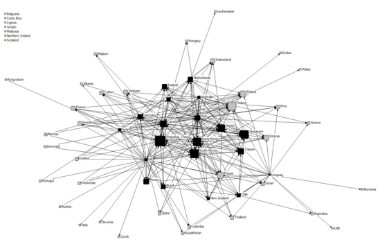A new course is in the books! Professor Oren Pizmony-Levy had taught a pilot of a course titled Social Network Analysis in the summer of 2020 and for a second time in the Fall of 2022. Due to the immense interest from students in social networks garnered from these pilots, the course has been officially added to the TC course registry titled ITSF 5009: Socal Network Analysis!
International and Comparative Education (ICEd) is ripe for looking at actors and institutions through the lens of social networks. Phenomena such as globalization, the spread of education models from one country to another and how education policies are created and diffused are just a few examples of ways to utilize social network analysis. This class specifically sets out to build students “methodological toolkits” or ability to carry out quality education research, analysis and evaluation which is essential for the ICEd field. In response to this need and to advancements in our field, the program is developing new methods courses, like ITSF 5009: Socal Network Analysis, and seeking other avenues to deepen and strengthen students' research methodologies.
So, what is the course all about? Pizmony-Levy argues:
Networks are everywhere, but most often invisible. Therefore mapping and understanding social networks have important implications for policy and practice. The course serves as an introduction to social network analysis, with a special focus on applications in comparative and international education. The theoretical heart of this approach to social science is that actors are interdependent, and that social structure emerges from regularities in this interdependence. The methodological idea behind social network analysis is based on graph theory. Through lectures and discussions of the assigned readings and materials, this course seeks to couple the theoretical and empirical development of social network analysis with methodological tools for conducting social network analysis.
We asked students who took the course this fall about their main takeaways. Arnela Colic, a second-year doctoral student in the ICEd program, shared that she appreciated learning about how social network analysis views the social world and how different it is from other perspectives in social research. This difference, she explained, is that often research methods do not allow us to see how actors within a network interact with one another. The visualization, or web, of social networks, creates a helpful image when investigating the “role of actors, the composition of ties, different network modes, densities, blocks, and cliques”, says Sumit Karn, a second-year ICEd masters student. Reading articles from Mark S. Granovetter (The Strength of Weak Ties) and Mario L. Small (Someone to Talk to), among others, supported students' use of original data (gathered by Professor Pizmony-Levy from one of his previous classes) to understand the complexity of networks and advanced statistical models using the UCINET tool.
We also spoke with second-year ICE master's student, Richaa Hoysala, who shared that her most significant takeaway from the course was that she needs to look beyond the individual characteristics of actors as predictors of actions and outcomes. The relationships of actors with others and our positions in various social networks have a significant influence on other actors. This directly links to how ideas are formed, passed on, and institutionalized in education policy and practice. Richaa learned a lot from the opportunity to replicate a study that used social network analysis to examine how media outlets in different counties reference other countries when reporting about the OECD PISA 2012 results.

The resources used in class, said ICEd doctoral student Tomás Esper, grounded his learning in visuals, and examples of social network analysis and solidified the practicality of this method of social network analysis. This TEDTalk of Nicholas Christakis, who speaks about the Hidden Influence of Social Networks, supported students in visualizing how actors are continually connected in a social web. Additionally, websites such as Open Syllabus Explorer and Connected Papers that map how syllabi are connected through sharing common scholars and texts were helpful in thinking through how even documents are connected through citations.
This is an exciting new addition to the ICE program’s coursework. Fortunately, this course will be offered this summer! We are thrilled for future masters and doctoral students to learn all about social networks.
